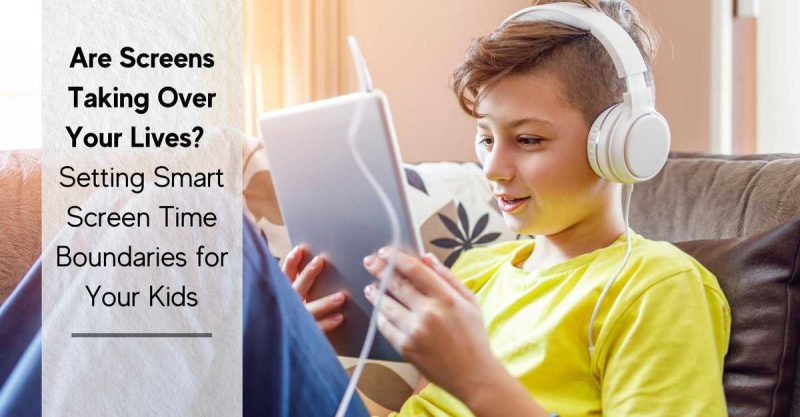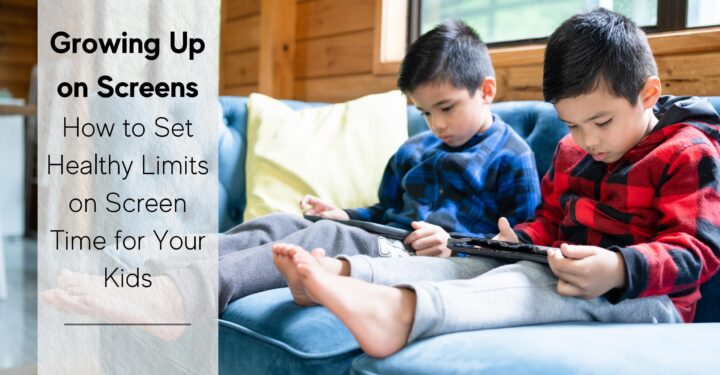Screen Time Guidelines – Screen Overload?

In today’s digital age, screens have become an integral part of our daily lives. From smartphones and tablets to computers and televisions, screens are virtually everywhere. While these devices offer immense benefits in terms of education, entertainment, and connectivity, there is growing concern about the potential negative impact of excessive screen time, especially for children.

So, how much screen time is too much? Are there any guidelines to help parents navigate this digital landscape?
The Ultimate Screen Time Guidelines for Kids
As parents, it is crucial to strike a balance between allowing our children to benefit from technology while also ensuring they have a healthy lifestyle. This balance can be achieved through screen time guidelines specifically tailored for kids. The American Academy of Pediatrics recommends the following guidelines:
Younger Kids (Ages 2-5):
- Limit screen time to 1 hour per day.
- Choose high-quality educational content.
- Engage in interactive activities alongside screen time.
Older Kids (Ages 6 and above):
- Set consistent limits on the amount of time spent on screens.
- Encourage physical activities and social interactions.
- Establish screen-free zones, such as family meals and bedrooms.
Screen Time, Digital Wellness, and Tech Balance
Digital wellness is a term used to describe the conscious and healthy use of technology. It emphasizes the importance of finding a balance between screen time and other activities. By implementing screen time limits and encouraging a variety of offline activities, we can ensure our children develop a well-rounded lifestyle that promotes physical, emotional, and cognitive well-being.
Healthy Screen Time and Tech Guidelines
When it comes to screen time, quality matters as much as quantity. Instead of mindlessly consuming digital content, it is vital to prioritize quality over quantity.
Here are a few tips to encourage healthy screen time:
- Choose educational and age-appropriate content that promotes learning and critical thinking.
- Engage in co-viewing or co-playing with your child to enhance the learning experience and promote meaningful interactions.
- Encourage active screen time, such as engaging in physical exercise, creative pursuits, or problem-solving games.
Parenting Tech and Digital Parenting
As parents, we play a vital role in guiding our children’s technology usage. Digital parenting involves setting boundaries, teaching responsible online behavior, and being engaged in our children’s digital lives.
Here are some key aspects of digital parenting:
- Model healthy screen time habits by practicing what you preach. Be a good role model for your child.
- Discuss the potential risks and benefits of technology with your child, helping them understand the importance of responsible usage.
- Encourage open communication and establish a trusting relationship so that your child feels comfortable discussing any concerns or issues they encounter online.
Screen Time Management – Finding the Right Balance
While screen time guidelines provide some structure, it is essential to remember that they are not rigid rules. Each child is unique, and their screen time needs may vary. As parents, we must find the right balance that works for our family dynamics.
Here are a few additional tips for effective screen time management:
- Set clear expectations and enforce consistent screen time rules.
- Promote a variety of other activities, such as physical exercise, reading, hobbies, and family time.
- Consider using parental control features on devices to limit access and filter content.
- Monitor your child’s screen time and observe any changes in behavior or mood that could be related to excessive usage.
Screen time guidelines are an essential tool for navigating the digital landscape and ensuring our children’s well-being. By establishing limits, promoting healthy screen time habits, and actively engaging in our children’s digital lives, we can strike a balance between technology and other activities.
Remember, it’s not about demonizing screens but rather using them in a mindful manner that enhances our children’s overall development and happiness!
Resources for Parents
American Academy of Pediatrics – Family Media Plan Please visit the site and ask each member of the family to develop their own media plan. Parents will need to assist younger children. Everyone should share the plan during a family meeting and make a pledge to follow the plan.
Common Sense Media Visit the website and signup for the newsletters relevant to your family. Visit the site with each of your children to help them to select beneficial digital media content as well as books, games, and current movies.
Recommended Reading
Parenting in a Tech World: A handbook for raising kids in the digital age








